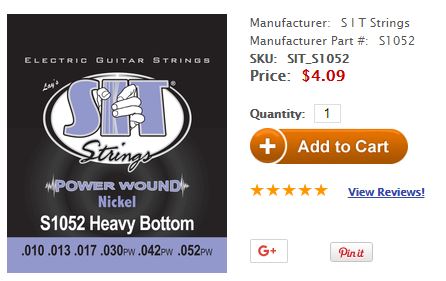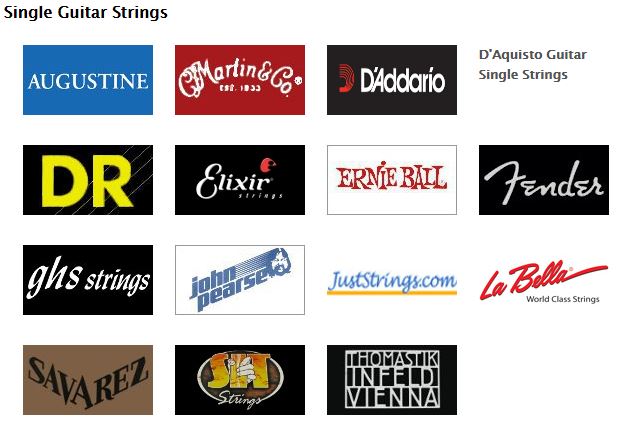The sixth string on my electric guitar is very loose when I use drop D tuning, but I really like the feel of the thinner strings otherwise- and I play as much in standard tuning. Would it work to have a thicker string only for the one I sometimes tune down? If so are there sets of strings you can buy like this?
-
1Something like Ernie Ball "skinny top heavy bottom" might suit, 10 to 52... but it really depends on what gauges you currently use. Some people think 10 is already 'heavy'.– TetsujinCommented Jun 20, 2018 at 17:41
-
1If you're going to try out heavy strings, just keep an eye on the nut. Heavy strings don't always sit in the grooves on the nut correctly. Or conversely, if the guitar is set up to use heavy strings, then lighter strings might not fill the grooves well and they could shift around and get detuned easily. If the nut is cheap, you might want to replace it and have the grooves made to fit the string set you like the most.– RingoCommented Jun 21, 2018 at 0:22
4 Answers
I've used non-standard strings for the last 40 or so yrs. Unfortunately, I can't buy them in sets, so I buy 10 of each at a time - making up 10 sets. Price then comes close to 10 standard sets.
That doesn't really answer your question, but to do so, yes, use a slightly different gauge for the bottom one. The guitar may benefit from a tweak of the trussrod, but I doubt it. It may also need the action and intonation checking, with a different string. In the meantime, look around for another guitar, so you can have one standard tuned, and another as you want it. Bargains are worth keeping an eye out for!
-
I agree with everything you said (plus 1). I order single strings from just strings. I order as many as I can get for the minimum shipping costs. If you order enough, you can get free shipping. There are probably other ways to order single strings online. I think that may be what you meant by buying "10 of each at a time". Or do you buy 10 sets and mix n match? Commented Jun 22, 2018 at 16:19
-
@RockinCowboy - certainly wouldn't buy 10 sets in order to not use some gauges! I have been known to redefine Scrooge! 10 of each works for me. Out of interest, generally - 008, 010, 012, 024, 028, 042. And they stay in tune better than most. Not-so-stressed, see! Incidentally, Just Strings was the only place in the world who could supply a double ball tapewound low B for a Steinberger headless/fretless I use occasionally.– TimCommented Jun 22, 2018 at 16:28
-
I've been very happy with Just Strings. I play acoustic so my strings are much heavier. But I like to use 010, 012 as my plain steels and the thinnest G string I can find (for guitar I mean). But I use much heavier E, A and D strings cause I like to use alternate bass note picking in my strumming patterns and sometimes incorporate bass lines into my arrangement if covering a song that features the bass line (ie The Joker by Steve Miller Band). I also like to use bass walk downs between chords. And I like drop D tuning. Slinky tops let's me play lead lines with bends. Commented Jun 23, 2018 at 18:40
-
@RockinCowboy - 'the thinnest G string'. What's that? How can a string be called any letter these days? 50 yrs ago, that's how they were identified, but now, you can but whatever gage you want. You could then use a .007" (poss. .006") gauge string and call that a G. Be quite floppy though!– TimCommented Jan 3, 2020 at 8:11
-
FWIW Tim. A common joke used by guitarist performing in bars here in the US - Whenever we break a string we say "my G-string just broke" regardless of which string actually broke. Interestingly, the 3rd string (if using a wound string) is the most common one to break because it has the thinnest diameter steel core (significantly thinner than the 1st string). In standard tuning that would be the G string so the joke is usually accurate. I keep extra G strings in my guitar case at all times. Might be a joke that only makes sense to Americans. (en.wikipedia.org/wiki/G-string) Commented Jan 3, 2020 at 21:00
There is no reason why you cannot mix strings. You don't need to stick with a standard set, you can create a custom set (I have for years). If you deviate just a little from a standard set you'll probably be fine. If you do something severe you may need to adjust the truss rod to compensate for the extra tension.
I use "heavy bottoms" on some of my guitars and I don't have any issues with floppy 6th string on drop D tuning. Some manufacturers make sets with what they call heavy bottoms.
But you might not be happy with the gauges the manufacturer chose for the sets that are available. So what I do is purchase individual strings to get exactly the gauges I want. There are many string manufacturers who sell strings individually, and while it's more expensive per string than buying a whole set, it's less expensive than buying 2 different sets just to get one set with the gauges you are looking for. If you only want the low E to be heavier, you could just buy a few of those.
The other consideration is the width of the slot in your nut for the 6th string. If you get a string that is too thick to properly seat in the slot, you (or a qualified guitar tech) will need to enlarge the nut slot with the proper file. You must be careful not to make the slot too wide because you don't want the string to have room to wiggle around in the slot.
Most electric guitars have adjustable saddles so you may need to adjust the intonation on the 6th string after changing to a different gauge. You can find information on adjusting your intonation in the answers to this (What is intonation and how can I find out if my guitar has correct intonation?) question on this site.
I would not advise you to go too heavy on just the low E because the increase in tension relative to your other strings at just one side of the neck could possibly twist the neck if left tuned over a long period of time. If you did go much heavier on just the low E string and want to be sure that the neck will not want to twist, you could leave the guitar tuned in drop D when you weren't playing it.
Or as Tim suggested in his answer, have a dedicated Drop D guitar on standby for any songs you play using drop D. You will thusly be inspired to add many more drop D songs to your repertoire. And while I don't need much of an excuse to buy another guitar - it never hurts to have one ;-).
Have fun.
-
Nut width is an important consideration if you keep swapping strings. Yet another reason why guitars should have that zero fret ! How many guitars does one need? One fewer than one already has...– TimCommented Jun 22, 2018 at 16:35
-
@Tim Thanks for fixing the typo. Surely you meant "one more than one already has.." You can never have too many! I did accidentally (should have looked closer at the pics) buy a lefty guitar that I need to unload though. Commented Jun 23, 2018 at 18:45
Along with the other answers, I will encourage you to do so by giving the example of Shavo Odadjian, bassist of System of a Down. He uses a B string in stead of the E string, also because it would be too loose (they use drop C tuning).
-
Really don't know why that bassist hasn't done what I did: took an ordinary 4 string, and strung it BEAD. Very simple solution. Or, better still, get used to playing a fiver... I'm very sceptical about this 'I have to have drop x tuning'!– TimCommented Jun 22, 2018 at 16:40


